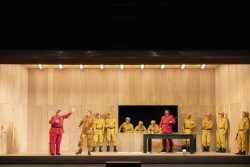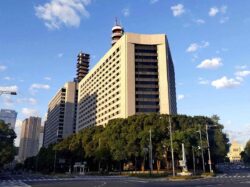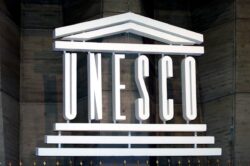Aged Tokyo National Theatre Without Prospect of New Construction; No Progress Made After Being Closed More than One Year
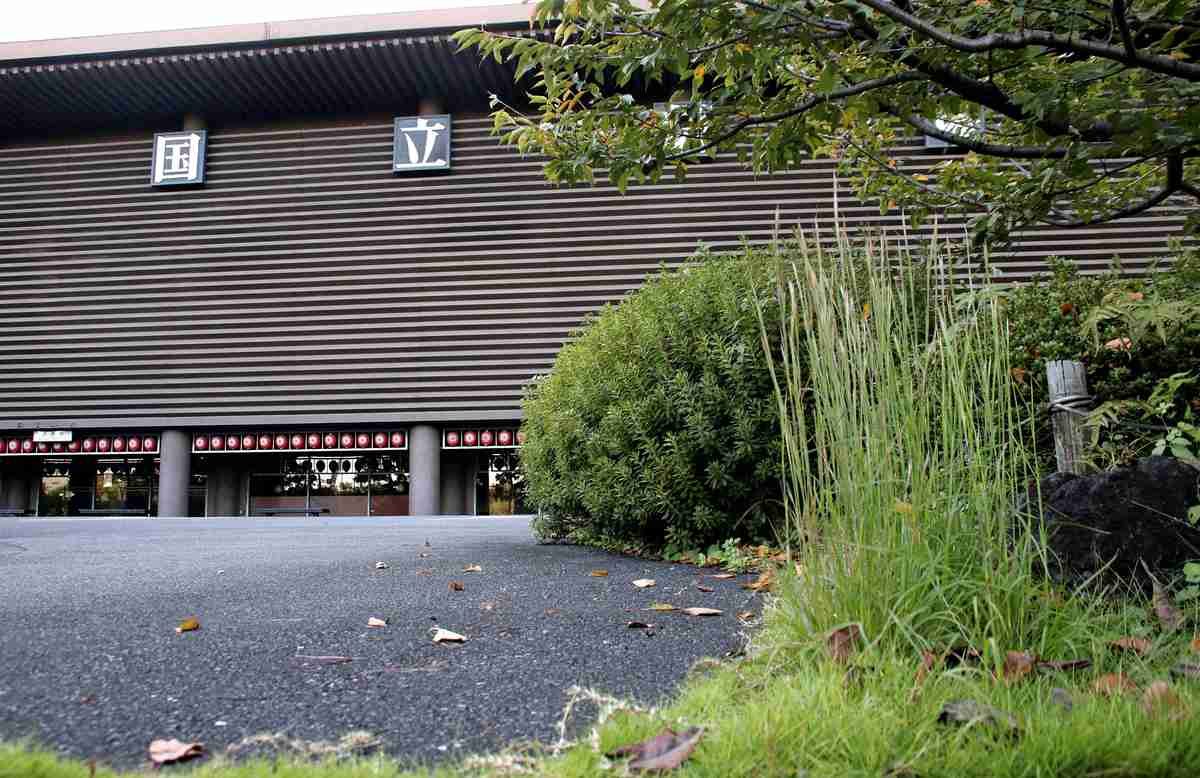
The National Theatre in Chiyoda Ward, Tokyo, which was closed at the end of October last year
17:22 JST, December 9, 2024
More than a year after the aged National Theatre in Chiyoda Ward, Tokyo, was closed to be replaced with a new building, there are still no prospects for its reopening, as no contractor has been chosen for its construction and post-completion operation.
The National Theatre, which houses a large theater and a smaller theater in the same building, was opened in 1966. As it is a venue for various traditional performing arts, its continued closure may jeopardize their preservation for future generations.
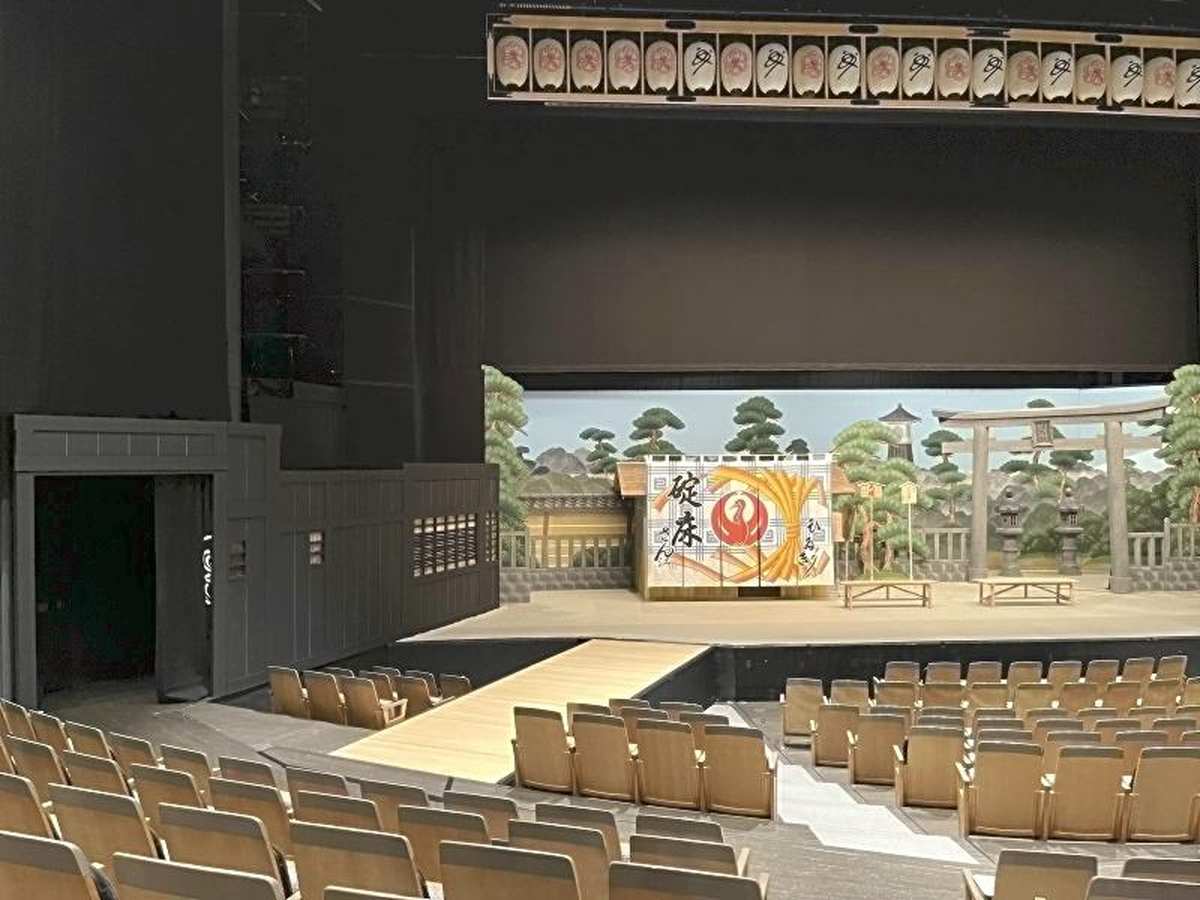
The stage setting of a scene from a “Natsumatsuri Naniwa Kagami” performance given at the New National Theatre, Tokyo, in Shibuya Ward, in September, with a short, temporary hanamichi runway leading into the audience area
On Sept. 2, the popular kabuki play “Natsumatsuri Naniwa Kagami” was performed at the midsize theater of the New National Theatre, Tokyo, in Shibuya Ward, where ballet and contemporary plays are usually performed.
At the theater, a shortened hanamichi raised runway, similar to the ones typically found at kabuki theaters, was temporarily set up. The hanamichi merged with an audience aisle in the middle of the seating area rather than extending from the stage to the rear of the theater. More than half of the roughly 920 seats were empty, and the applause was considered underwhelming for a kabuki performance.
Since the closure of the National Theatre, kabuki and bunraku performances organized by the theater have been held at the New National Theatre and other rented venues such as public halls in the Tokyo metropolitan area. None of them are available for extended periods of time.
Bunraku performances, including educational events, were held on 77 days in fiscal 2018 but are expected to be held on only 61 days this fiscal year. The seat occupancy rate, which was about 86% in fiscal 2018, is expected to substantially drop this fiscal year, as attracting new audiences is challenging.
Soaring costs, failed bids
Demolition of the old theater building has yet to begin.
The annual budget of the Cultural Affairs Agency, which oversees the theater’s operator, the Japan Arts Council, is a little over ¥100 billion. The construction project would require a comparably large sum of money. The government selected the private finance initiative (PFI) method to raise funds.
According to the government’s plan, this means a private sector contractor will be selected through a competitive bidding process to be entrusted with the entire project, including the demolition and construction, as well as the maintenance and management after completion. The contractor will be permitted to include commercial facilities, such as a restaurant, in the new theater building. A long-term contract will be concluded to allow the government to pay construction costs in installments, which enables construction with a lower annual budget.
The council invited bids with a condition that the new theater building include a suitable hotel among its commercial facilities.
Although the council announced two bidding periods, the first in 2022 and the second in 2023, all candidates withdrew before the first bidding was held, and the second bidding was also unsuccessful because the contract price was significantly lower.
The main reason for the failed biddings was that the planned budget no longer met the actual construction costs due to surging material and labor expenses.
According to sources, the market cost of the construction project was about ¥130 billion, much higher than the contract price of just over ¥80 billion. Market costs have continued to soar and are estimated to have reached about ¥140 billion.
The council’s survey has also revealed that potential contractors have doubts about the accessibility and consequent profitability of a hotel in the theater’s current location, which is close to the Imperial Palace and the Supreme Court but somewhat distant from commercial areas. They are also concerned about the numerous possible restrictions on construction work, such as the Metropolitan Expressway running underneath the site.
Change of policy
The Liberal Democratic Party set up a study team to deal with the stalled situation in March.
During its discussions, some team members said that the government should invest more money without relying too much on PFI. They also suggested that the government should renovate the theater building as a temporary measure to extend its use and then plan carefully for the construction of a new theater.
In June, the government clearly wrote in the Basic Policy on Economic and Fiscal Management and Reform that it “will take responsibility for the implementation [of the construction project] as early as possible.”
A governmental study team has announced a policy that would retain the use of PFI but give more freedom to the contractor, such as removing the requirement of including a hotel.
The agency has allocated funds for construction work in its budget request for fiscal 2025, but it is unclear how much funding can be secured. Once the budget is in place, it will be necessary to revise the construction plan and decide on new bidding conditions.
Hisahiro Sugiura, acting president of the council, says that the next bidding can take place in fiscal 2026 at the earliest. It is expected to take about six years from the bidding to completion, including the design and demolition processes. It is almost certain that the reopening, which was originally scheduled for fiscal 2029, will be significantly delayed.
The council also made a calculation of the construction within the current budget. In that case, a drastic downsizing would be necessary, such as reducing the seating capacity of the larger theater from about 1,600 to about 600.
Sugiura said: “Traditional performing arts are an important part of Japanese culture, even though they are not always profitable. We are asking for an increase in budget and for the understanding of the public.”
Education, Culture, Sports, Science and Technology Minister Toshiko Abe said at a press conference on Oct. 11, “We will work to reopen the theater as soon as possible.”
The National Theatre also plays an important function in preserving traditional performing arts to pass them on to future generations, including training young performers. It also provides an opportunity for foreign visitors to learn about Japanese culture.
Ensuring an adequate budget and speedy implementation is necessary to maintain the status and value of the theater that represents the art and culture of Japan.
Traditional performing arts at risk
The National Theatre has also been an important base for professional nihonbuyo Japanese traditional dance and traditional Japanese music performers.
In fiscal 2022, the larger theater was rented on 73 days and the smaller theater on 125 days to hold performances and other events. The longer the theater building is closed, the harder it will be for those involved to secure performance venues.
Shamisen player Imafuji Chojuro, vice president of the Nagauta Kyokai association for promoting the nagauta music genre, said: “Ordinary theaters are not suitable for traditional performing arts” in terms of the width of the stage and the acoustic effects for the music.
A professional traditional Japanese musician in his 30s has experienced a 60% decrease in income compared to before the COVID-19 pandemic.
He says that the loss of performances organized by the National Theatre is more damaging, as it has reduced the opportunities to perform important traditional pieces.
“If we can no longer perform traditional pieces together with their many important components, we won’t be able to pass on the art to the next generation,” the musician said. “I feel that the traditional performing arts are disappearing at an accelerated rate.”
Tsuneo Asahara, an advisor to the Japan Actors’ Association who has been involved in the administration of the kabuki world for many years, said, “The National Theatre has focused on three pillars of kabuki: performing long plays in their entirety [not just highlight scenes], reviving old plays and presenting new plays. Many of these programs have become assets to the kabuki world. [The National Theatre] has also provided training opportunities for young performers.”
Asahara also said: “I hope that many people, including those who are not very interested in traditional performing arts, will rediscover the splendor of traditional culture, which has naturally integrated into Japanese daily life, and think about the importance of its continuation.”
"Culture" POPULAR ARTICLE
-
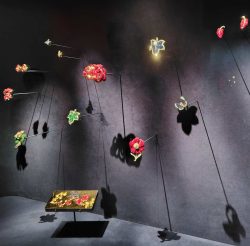
Van Cleef & Arpels Dazzles with Art Deco Artisanry at Tokyo Exhibit
-

Disney’s ‘Twisted-Wonderland’ Animated Series Puts Villains in Spotlight: New Show Features School Inspired by Classic Disney Films
-

Ayumi Hamasaki’s Shanghai Concert Canceled Day Before Schedule as Part of Beijing Backlash
-

‘The World Masterpiece Theater Series’ Celebrates 50 Years; Animator Looks Back on Creating Anime Classics
-

Popularity of Piggy Banks Across Time and Place Seen at Bank’s Museum of Money Boxes in Hyogo Pref.
JN ACCESS RANKING
-

Tokyo Economic Security Forum to Hold Inaugural Meeting Amid Tense Global Environment
-

Keidanren Chairman Yoshinobu Tsutsui Visits Kashiwazaki-Kariwa Nuclear Power Plant; Inspects New Emergency Safety System
-

Imports of Rare Earths from China Facing Delays, May Be Caused by Deterioration of Japan-China Relations
-

University of Tokyo Professor Discusses Japanese Economic Security in Interview Ahead of Forum
-

Japan Pulls out of Vietnam Nuclear Project, Complicating Hanoi’s Power Plans


_0001-250x189.jpg)
